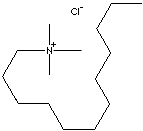| DODECYLTRIMETHYLAMMONIUM CHLORIDE | ||
|
PRODUCT IDENTIFICATION |
||
| CAS NO. | 112-00-5, 19486-61-4 |
|
| EINECS NO. | 203-927-0 | |
| FORMULA | CH3(CH2)11N(Cl)(CH3)3 | |
| MOL WT. | 263.89 | |
|
H.S. CODE |
2923.90 | |
|
TOXICITY |
||
| SYNONYMS | Trimethyl-1-dodecanaminium chloride | |
| N,N,N-Trimethyl-Dodecanaminium chloride Laurtrimonium Chloride Lauryl Trimethyl Ammonium Chloride n-Dodecyl Trimethylammonium Chloride Cloruro de dodeciltrimetilamonio (Spanish) chlorure de dodé cyltrimethylammonium (French) | ||
| SMILES | ||
|
CLASSIFICATION |
|
|
|
PHYSICAL AND CHEMICAL PROPERTIES |
||
| PHYSICAL STATE | white crystalline powder | |
|
MELTING POINT |
> 235 C | |
| BOILING POINT |
| |
| SPECIFIC GRAVITY | ||
|
SOLUBILITY IN WATER |
soluble | |
|
pH |
||
|
AUTOIGNITION |
||
| VAPOR DENSITY | ||
|
NFPA RATINGS |
Health: 3 Flammability: 0 Reactivity: 0 | |
|
REFRACTIVE INDEX |
||
| FLASH POINT | ||
| STABILITY |
Stable under ordinary conditions. Moisture sensitive. | |
|
GENERAL DESCRIPTION & APPLICATIONS |
||
Quaternary ammonium compounds are any of a group of ammonium salts in which organic radicals have been substituted for all four hydrogens of the original ammonium cation. They has a central nitrogen atom which is joined to four organic radicals and one acid radical. The organic radicals may be alkyl, aryl, or aralkyl, and the nitrogen can be part of a ring system. They are prepared by treatment of an amine with an alkylating agent. They show a variety of physical, chemical, and biological properties and most compounds are soluble in water and strong electrolytes. Such compounds include
They have properties of disrupting micro-organisms' cell processes and surfactants. These compounds are used as
|
||
| SALES SPECIFICATION | ||
|
APPEARANCE |
white crystalline powder | |
| ASSAY |
99.0% min | |
| TRANSPORTATION | ||
| PACKING | 20kgs in drum | |
| HAZARD CLASS | 8 (Packing Group: III) | |
| UN NO. | 1759 | |
| GENERAL DESCRIPTION OF PHASE TRANSFER CATALYSIS |
||
'Phase transfer catalysis (PTC)' methodology is a powerful tool improving
process efficiency, product selectivity and providing mild reaction conditions
in organic chemical reactions. In many chemical reaction situations, there are
different species (immiscible liquids or solid and liquid) which don't react
each other due to separation by an interface. Small quantity of
��phase-transfer catalyst��, involves a substrate (soluble in the organic layer)
and an anionic reagent or a nucleophile (dissolved in the aqueous layer),
extracts one of the reactants, most commonly an anion, across the interface into
the other phase where reaction can take place with the substrate and reaction
can proceed. The quaternary ammonium salts can carry the nucleophile from the
aqueous to organic phase and are used as the most commonly used as
phase-transfer catalyst. The phosphonium derivatives favoring higher thermal
stability property are also used. Crown ethers and polyethylenglycol compounds
are also widely used in this application. |
||
| OTHER INFORMATION | ||
| Hazard Symbols: XI, Risk Phrases: 36/37/38, Safety Phrases: 26-36/37/39-45 | ||
| GENERAL DESCRIPTION OF ANTISEPTIC AGENT | ||
|
Antiseptic agent is a substance which kills or inhibits the growth of disease-causing bacteria and other microorganisms. It is essentially nontoxic to to be applied to the skin or mucous membranes. (Disinfectant including cresol, bleaching powder, and phenol is in general toxic to cells of the body). Common antiseptic agents are Benzalkonium Chloride, Cetrimide, Chlorhexidine, Hexachlorophene, Iodine Compounds, Mercury Compounds (Thimerosol), Alcohol and Hydrogen Peroxide, Hexamine Hippurate, Triclosan, Cetylpyridinium Chloride, And Dequalinium. Other substances which can be used for antiseptic purpose include Boric acid and volatile oils such as Methyl Salicylate. Hexachlorophene and Benzalkonium Chloride are used primarily in hand or face washes. Benzalkonium Chloride must not be applied to areas which have not been fully rinsed as it is inactivated by organic compounds. Benzalkonium application many include disinfecting instruments and preservativing drugs in low concentration form. Iodine compounds have the widest spectrum of antiinfectives against bacteria, fungi, spores, protozoa, viruses, and yeasts. Aqueous iodine are less effective than alcoholic solutions, but alcoholic component is drying and irritating to abraided skin. Povidone iodine is convenient to use as it is less irritating, but not as effective. Chlorhexidine is used as a safe antiseptic or disinfectant to apply to prevent body infection and in oral rinses for treating sore gums and mouth ulcers and preventing plaque on teeth. It is used in the form of acetate, gluconate or hydrochloride, either alone or in combination with others such as cetrimide. Cetrimide is an antiseptic agent with detergent properties. It has the wide spectrum of antiinfectives against bacteria and fungi. It is used as an ingredient of shampoos for treating seborrhoea and psoriasis. A very dilute solution can be applied topically for the relief of sore gums. Hippuric Acid, an amino acid glycine, is excreted from the body and is used in urinary system drugs. Hexamine hippurates is helpful for preventing and treating infections of the urinary system it acts by being transformed to formaldehyde. Triclosan is a very popular antibacterial agent. It is used in hospitals for cleansing and disinfecting the skin of patients and surgeons. It is used in cosmetics, household goods and personal care products. It is also used in plastics and textiles for antibacterial activity purpose. Cetylpyridinium chloride is used in oral rinses for cleaning mouth and treating minor throat or mouth infections and teething problems. Dequalinium chloride is antiinfectives against bacteria and fungi. It is used in treating bacterial or fungal infections of mouth and throat. |
||
| PRICES | ||
